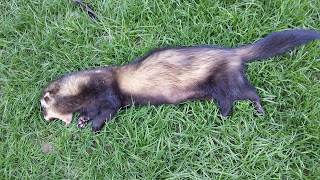'Safety was paramount': council defends decision to shoot Lillith the lynx
I felt I had to begin with this outrageous story today: Nov 11 2017: An Eurasian lynx was shot after straying into a caravan park near Aberystwyth town centre almost two weeks after its escape from Borth Wild Animal Kingdom. Asked why the animal could not have been darted, Andrew Venables, a marksman said, it was necessary to get within 10 to 15 metres of an animal to tranquilise it, with the the dart then taking up to 15 minutes to take effect.
The park had said the 18-month-old lynx did not pose a danger to humans but had warned the public against getting too close. There have never been any recorded attacks by a lynx on a human, according to the park.
I have abridged this text above because there was and is plenty more to say. I am disgusted by what happened here. Once again, there were spurious claims by farmers of it attacking their sheep and there seems to have been a knee-jerk reaction. Just look at this beautiful animal! When are we EVER going to learn to respect an animal's right to life?
I have had my little rant (which I sanitised from what I really felt) but if you disagree and think I am wrong, I would be happy to hear about your reasons too.
During the first week of November this year, I spotted a strange looking roadkill. I had to turn the car around and investigate. This is what it turned out to be (apologies for posting a photo of a dead animal, but it's an important part of the story)...
I still wasn't sure if this was a ferret, polecat, or a hybrid. Whilst chatting to my good friend and entomologist Tim Ransom one evening, it dawned on me that he might be the best person to ask for advice and so I shared my photos with him.
Tim pointed out that it's hard to be sure from a photo and that it can be tricky to tell hybrids from true polecats, but in his opinion, it might well be a polecat.
Next stop was Kent Wildlife Trust, who have been asking for any rare animal sightings. Here is the reply from Stephen Weeks - Medway Valley Warden :
Hi John
It’s always tricky to tell them apart from photos and I’m no expert, but your photos does show one of the characteristics you’d expect from a polecat (the dark markings on the face extend to the nose – on a ferret there is usually a pale band across the top of the nose). However ferrets can be very varied in their patterns.
One thing to check, if you still have access to the body, is whether there is a pale throat patch (in polecats it is absent or less than 5cm – greater than 5cm in ferrets). Also, the black along the back shouldn’t have any white guard hairs in polecats, but scattered white hairs in ferrets.
And so, I did check as suggested: no throat patch and no white hairs along the back.
The Wildlife Trust pointed me in the direction of The Vincent Wildlife Trust who had carried out a nationwide survey in 2014/15 and interestingly had no reports of polecat sightings at all in this part of Kent. They did produce an interesting leaflet though with identifying tips...
I had this reply from Lizzie Croose - Mustelid Conservation Officer:
Hi John
Thanks for your email. As you’ve noted, we didn’t receive any records of polecats in West Kent during the national polecat survey (2014-2015). Of course, that doesn’t mean there weren’t any in the area, as it’s plausible they were present in low numbers but went unrecorded. We have not been collecting polecat records since the national survey finished at the end of 2015, so unfortunately I don’t know what has happened since then, but it’s possible polecats have spread into West Kent. The Kent Mammal Group may know as they may have received more records.
Sorry to not be of more help.
Best wishes
Lizzie
I fired off an email to the Kent Mammal Group and the very next day had this reply from them:
Hi John
Thanks for getting in touch and your sighting is very interesting. I believe that hybrid polecat/ferrets are living wild in Kent but sadly the chances of finding a genetically pure polecat are very slim. I have however passed your message to a colleague who may be able to give you some more information, he is currently away but will I’m sure be in touch with you soon.
In the meantime can I ask if you were able to get a photo of the animal you found? in particular its face?
Thanks again John.
Jason
I mailed Jason the pictures that I have and am now awaiting a reply. I will update you as soon as I do hear back. I am really hoping that this can be identified as a true polecat, even though I acknowledge the chances are slim. It would be a very exciting find.
As this entry has by default been a tad wordy, I shall cut and run here and return with another update soon. Thank-you to anybody who was interested enough to get this far.








3 comments:
That poor lynx. I was incensed by the stupidity of it all as well.
Fascinating about the polecat/ferret! Look forward to catching up with the news in future blogs! :-)
Hi again Maria,
Yes infuriating eh!!! Sadly, despite being promised further information from another wildlife expert, once they returned from holiday, and my sending a reminder a few weeks later, I never did hear from them again...
A shame, but so often is the case!
Post a Comment